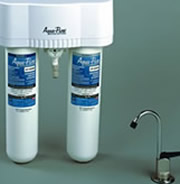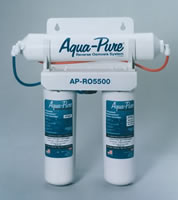Dangers of Lead Pipes in Your Home’s Plumbing System
A dangerous contaminant can be lurking in your home's plumbing system - lead. Lead pipes are particularly plentiful in homes that were constructed before 1986 and can be a source of lead exposure. While exposure to lead is not good for any person, it can prove particularly harmful to young children and pregnant women. The Environmental Protection Agency's (EPA) current estimates hold that as many as 40 million Americans regularly consume water that contains lead in excessive levels. The source of most of this exposure to lead is from water being piped through lead pipes and the longer that water remains in the pipe before being dispenses from a tap, the higher level of lead it contains.
|
|
EPA Regulation of Lead
If lead is such a problem, doesn't the government intervene? Although the government is aware of the serious risks that lead can impose, it does force homeowners to take action. The government agency that regulates lead is the EPA. Since 1991, the EPA's Lead and Copper Rule have established an action level that is applied to the amount of lead that is permissible in drinking water - 15 parts per billion, as part of the Safe Drinking Water Act. This EPA rule requires that water systems collect samples directly from the tap of the water customer, as opposed to determining compliance by measuring the lead content in water at the source. Under this rule, the government can only take action if ten percent of the households tested exceed the action level. As you can imagine, government intervention for lead is rare because of this rule as it is the lead pipes in older homes, not the water source, which is behind the contamination in most cases.
Dangers of Lead
Lead is a useful element that has been used in various consumer and building products for hundreds of years. But what we didn't know about lead until the past few decades is that it is a toxic metal that can be very harmful to the health of human beings if it is ingested or inhaled in amounts that are great enough to cause damage. While nearly everyone is aware of the dangers of lead-based paint, few people consider that the pipes in their older plumbing systems can be a huge problem as well. Lead that builds up over many years in the body can cause severe damage to the brain, kidneys, liver and red blood cells. Children exposed to lead can be functionally impaired (both physically and mentally) and show developmental problems. Because children under the age of six are still going through some of their most important developmental stages, they are particularly vulnerable to the dangers of lead, as are women who are pregnant and their unborn children. While a healthy adult may not be as susceptible to the dangers of lead, young bodies that are still growing can show a decline in physical and mental development.
What You Can Do Now to Reduce Lead in Your Drinking Water
While it may not be cost effective for you to replace all of the lead pipes in your home's plumbing system, there are steps that you can take to reduce the level of lead in your drinking water. Start by:
- Flushing your faucet. Flushing the kitchen faucet is helpful if water has been sitting in lead pipes for more than a few hours. The longer the water remains in the pipes, the higher the amount of lead it will contain. To do this, run the water from the pipes for around seven minutes, which is considered enough time for the water that was resting in the pipes to have been expelled down the drain. Don't want to waste this water? It's okay to catch this water in a bucket to water plants or flush the toilet with. It's also an optimal time after flushing the taps to run a pitcher of water for drinking.
- Water from the cold water tap should be used for consumption or cooking. Hot water contains higher levels of lead in most instances. Make sure that the water that you use for cooking is water that was obtained from the tap after it has been flushed because boiling water will increase the amount of lead in it.
- Consider purchasing water for use in making baby formula, or buy pre-mixed formula, as opposed to using water that is piped through lead pipes.
- Keep your faucets' aerators clean and particle free by cleaning them thoroughly once a week.
- Install a lead free faucet.
|
How a Water Filtration System Can Help
Perhaps the best way to end your worries about lead contamination in your home caused by lead pipes is to install a water filtration system that will remove the lead from the water before it reaches the tap. The type of system needed to combat lead exposure from lead pipes should be a carbon filter that is installed on the faucet or under the sink. An excellent product that serves this purpose is the Aqua-Pure AP-DWS1000 Deluxe Drinking Water System. It comes complete with a tap that has an under the sink filtration for less than $350. This dual filter in this amazing system that can filter as many as 625 gallons of pure water, and features an indicator that lets you know when it is time for a filter change. No matter which water filter brand you choose, be certain that it is NSF-certified. The National Sanitation Foundation is a not for profit organization that certifies water filters according to the type of contamination that they remove from drinking water. Ideally, an NSF 53 is needed to remove heavy metals like lead. A water filter of this caliber can also remove pesticides, cysts, and other pollutants. |
|







.jpg)
